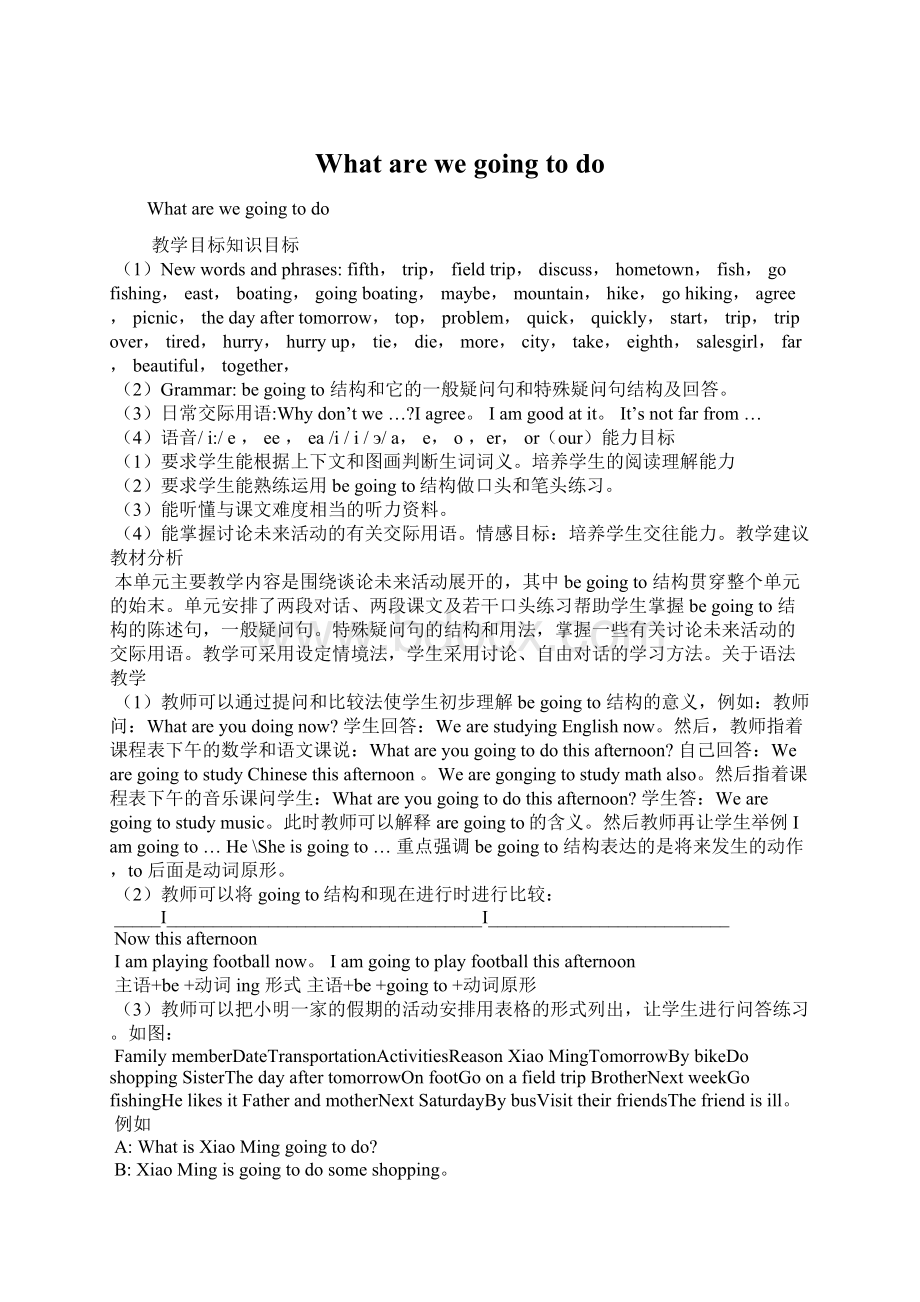What are we going to do.docx
《What are we going to do.docx》由会员分享,可在线阅读,更多相关《What are we going to do.docx(6页珍藏版)》请在冰豆网上搜索。

Whatarewegoingtodo
Whatarewegoingtodo
教学目标知识目标
(1)Newwordsandphrases:
fifth,trip,fieldtrip,discuss,hometown,fish,gofishing,east,boating,goingboating,maybe,mountain,hike,gohiking,agree,picnic,thedayaftertomorrow,top,problem,quick,quickly,start,trip,tripover,tired,hurry,hurryup,tie,die,more,city,take,eighth,salesgirl,far,beautiful,together,
(2)Grammar:
begoingto结构和它的一般疑问句和特殊疑问句结构及回答。
(3)日常交际用语:
Whydon’twe…?
Iagree。
Iamgoodatit。
It’snotfarfrom…
(4)语音/i:
/e,ee,ea/i/i/э/a,e,o,er,or(our)能力目标
(1)要求学生能根据上下文和图画判断生词词义。
培养学生的阅读理解能力
(2)要求学生能熟练运用begoingto结构做口头和笔头练习。
(3)能听懂与课文难度相当的听力资料。
(4)能掌握讨论未来活动的有关交际用语。
情感目标:
培养学生交往能力。
教学建议教材分析
本单元主要教学内容是围绕谈论未来活动展开的,其中begoingto结构贯穿整个单元的始末。
单元安排了两段对话、两段课文及若干口头练习帮助学生掌握begoingto结构的陈述句,一般疑问句。
特殊疑问句的结构和用法,掌握一些有关讨论未来活动的交际用语。
教学可采用设定情境法,学生采用讨论、自由对话的学习方法。
关于语法教学
(1)教师可以通过提问和比较法使学生初步理解begoingto结构的意义,例如:
教师问:
Whatareyoudoingnow?
学生回答:
WearestudyingEnglishnow。
然后,教师指着课程表下午的数学和语文课说:
Whatareyougoingtodothisafternoon?
自己回答:
WearegoingtostudyChinesethisafternoon。
Wearegongingtostudymathalso。
然后指着课程表下午的音乐课问学生:
Whatareyougoingtodothisafternoon?
学生答:
Wearegoingtostudymusic。
此时教师可以解释aregoingto的含义。
然后教师再让学生举例Iamgoingto…He\Sheisgoingto…重点强调begoingto结构表达的是将来发生的动作,to后面是动词原形。
(2)教师可以将goingto结构和现在进行时进行比较:
_____I__________________________________I__________________________
Nowthisafternoon
Iamplayingfootballnow。
Iamgoingtoplayfootballthisafternoon
主语+be+动词ing形式主语+be+goingto+动词原形
(3)教师可以把小明一家的假期的活动安排用表格的形式列出,让学生进行问答练习。
如图:
FamilymemberDateTransportationActivitiesReasonXiaoMingTomorrowBybikeDoshoppingSisterThedayaftertomorrowOnfootGoonafieldtripBrotherNextweekGofishingHelikesitFatherandmotherNextSaturdayBybusVisittheirfriendsThefriendisill。
例如
A:
WhatisXiaoMinggoingtodo?
B:
XiaoMingisgoingtodosomeshopping。
A:
WhenisXiaoMinggoingtodoshopping?
B:
Heisgoingtodosomeshoppingtomorrow。
A:
HowisXiaoMinggoingtodoshopping?
B:
Heisgoingtodoshoppingbybike。
笔头训练
(1)要求学生能够就口头训练落实到笔头上,教师可以设计一个话题,让学生自由完成后续部分。
例如:
明天是周末,你将怎样度过周末呢?
可写3-5句话。
教师还可以让学生自己作出下周的计划安排表,本周日活动或国庆节假期活动安排表,然后就这些安排表进行详细的描述。
教师还可以让学生就课程表中第二天的课程安排进行描述。
(2)教师可以出示几张图片让学生根据图片内容用begoingto结构写出要发生的事情。
如图1。
Itishot。
WhatisXiaoMinggoingtodo?
图2Itissnowy。
Whatarethestudentsgoingtodo?
图3。
MaryandLiPinggottothefarm。
Whataretheygoingtodo?
关于教学表将来打算begoingto用法的几点建议
①提问若干学生将来的某时间要干什么。
一方面可提高学生的注意力,另外可让学生从老师将要讲述的内容中找到自己的答案。
②通过教材中的实例讲述将来时态的应用场景及其特点。
③讲解将来时态的构成要素,通过练习熟悉这些要素并引导学生对老师的提问进行作答,熟悉和掌握此时态。
④模拟练习,激发学生的学以致用的兴趣,让学生自己能够说出自己身边的将来时态的场景并进行问与答。
⑤总结godoing固定结构,讲解进行时态代表将来时态的具体事例。
情感教学在教学过程中让学生领略到山河的锦绣和大自然的美好,从而激发学生热爱自然,热爱祖国的大好河山。
让学生知晓中国悠久的文明历史,树立强烈的民族自尊心和自豪感。
从而使学生增加爱国意识,起到爱国主义教育的作用。
go+ving结构
固定搭配,表示动名词的意义。
常用来表示体育和业余活动。
例如:
gofishing去钓鱼,goboating去划船,goswimming去游泳,gohiking去远足,goshopping去购物,godancing去跳舞。
例句:
Let’sgoswimmingnextweekend。
Areyougoingtogofishingtomorrow?
egoingto
begoingto为固定结构,初学时应注意以下六点:
一、注意begoingto的意义
begoingto为结构表示按计划、安排将要发生的事,或经推测将要或肯定要发生的动作。
该结构通常译成“打算、准备”等等。
如:
I’mgoingtomendmybikethisevening。
我打算今晚修理我的自行车。
go在此结构中不含有“去”的意思。
二、注意be的变化
be在此结构中用作助动词,不作连系动词,有am,is和are三种形式,本身无意义。
1.否定式:
应在am,is或are后加not。
如:
Heisn’tgoingtobuythatpen。
他不打算买那支钢笔。
2.疑问式:
应将助动词be提到主语前,与be作连系动词的用法相同。
如:
Areyougoingtoseeyouruncletomorrow?
你准备明天看你的叔叔吗?
Yes,Iam。
是的,我准备去。
三、注意begoingto后接动词原形
to在此结构中为动词不定式符号,后须接动词原形。
如:
They’regoingtoplaygames。
他们打算做游戏。
四、注意begoingto结构须与表示将来的时间状语连用。
如:
We’regoingtohaveanEnglishclasstomorrow。
明天我们要上一节英语课。
五、注意当to后的动词为表示位置移动的动词,如go,come,leave,fly,start等时,一般不用begoingto结构,常用现在进行时表示将要发生的动作。
如:
I’mgoingtotheshop。
我要去商店。
一般不说I’mgoingtogototheshop。
六、注意Therebe结构一般将来时应为Thereis/aregoingtobe…。
如:
今晚有场电影。
误:
Thereisgoingtohaveafilmthisevening。
正:
Thereistogoingtobeafilmhisevening。
教学设计方案Lesson5Period:
TheFirstPeriodContent:
LessonfiveTeachingObjectives:
Studentsshouldmastertheuseof“begoingto”andshowtheirintentiontodosth。
LanguageFOCUS:
I。
Toshowtheintentiontodosth。
“begoingtodosth。
”
II。
usefulexpressions
1。
onafieldtrip
2。
3。
TeachingProcedures:
I。
Organizingtheclass
GreetingandadutyreportII。
Review
1。
Toactoutthedialoguestheymadeupashomework。
2。
Tomakeupsentenceswiththetimephrase。
now,atthemoment,Look!
,listen!
etc。
III。
Leading-in
Teacher:
OnSundays。
Ioftengoshopping。
Ilikegoingshopping。
WhatdoyoulikedoingonSundays?
Students:
Ilikeplayingcomputergames。
…
Teacher:
OK。
Thestudentsaregoingtogoontheirfieldtrip,theyaregoingtoplaysomewhere。
Let’sseewhattheylikedoingandwheretheyaregoing。
Studentslistentothedialogueandanswerthequestionsteacherasked。
Explainthephrase“begoodat”meanssomeonecandosthverywell。
eg。
“WendyisgoodatEnglish”means“WendysEnglishisgood,shecanspeakorwriteEnglishverywell。
”
Hike。
(gofora)longwalkinthecountry,takenforpleasureexercise。
StudentslistenagainandreadinpairsIV。
Practice
Supposeyourclassisgoingonafieldtrip,too。
Talkingroupsaboutwheretogo,whattodo,howtogo,etc。
Makeitaroleplay。
Andactitout。
V。
Askandanswer
Studentsworkinpairsaskquestionsintheboxandanswer。
Payattentiontothetimephrasestomorrow,nextweek,nextholiday,thedayaftertomorrow,etc。
VI。
Practice
Addmorephrasesdenotingthefuturetime。
eg,thisweekend,nextSunday,etc。
Studentsaskquestionsaboutfutureintention。
A:
WhatareyougoingtodonextSunday?
B:
Iamgoingtodomyhomework。
Whatareyougoingtodo?
C:
I’mgoingto…VII。
Exercisesinclass
1。
ThestudentsaregoingtohaveanEnglishexamnextmonth。
(1)What…?
(2)When…?
(3)Who…?
2。
HeisgoingtomovetoNewYorktomorrow。
(1)Negativesentence。
(2)generalquestionandanswers:
Yes/No。
(3)Where…?
3。
Completethedialogue。
-What____________________tomorrow?
-Nothingmuch。
why?
-I____________Plantsometrees。
Doyouwanttogowithme?
-Yes,I’dloveto。
Where________________plantthetrees?
-I____________thecountryside。
-How_______________getthere?
-Wecantakeabus。
-Good。
When____we___andwhere?
-Letsmeetat9:
00inthemorning。
IIIgotoyourhouse。
-OK。
Seeyoutomorrow。
-Seeyou。
Answers:
1。
①Whatarethestudentsgoingtodonextmonth?
②WhenarethestudentsgoinghereforanEnglishexam?
③WhoisgoinghereforanEnglishexamnextmonth?
2。
①Heisn’tgoingtomovetoNewYorktomorrow。
②IshegoingtomovetoNewYorktomorrow?
Yes,heis。
/No,heisn't。
③Whereishegoingtomovetomorrow?
3。
are,you,going,go,do,/am,going,to,are,you,going,to,/am,going,to,are,you,going,to,/will,meet,
VIII。
HomeworkTowriteashortarticletointroducewhatyouintendtodonextholiday。
IX。
Thedesignoftheblackboard
Lesson5gofishingAreyougoingto…?
begoodatdoingsth。
Yes,Iam。
haveafieldtripNo,I’mnot。
goonapicnic教学设计方案Lesson6教学目的(TeachingObjectives)
(1)掌握重点单词和词组hurryup。
gothewrongway,betired。
(2)熟练掌握begoingto结构的用法
(3)能回答课文的问题并能根据上下文判断单词的意思。
教具(Properties):
教学磁带,图片和卡片。
Properties:
taperecorder,calendar。
。
教学过程(TeachingProcedures)Step1Organizingtheclass
GreetingendadutyreportStep2Review
1。
TosaysentencesaccordingtothecalendaraboutCharlie’sholidayplan。
eg。
Charlieisgoingtocatchthenineo’clocktraintohisuncle’shome。
etc。
Step3Leading-in
T:
Lastlesson,wehaveknownthestudentsaregoingtohaveafieldtriptomountain。
Todaywe’regoingtoseewhattheymetontheirtrip。
Doyouthinktheyhaveagoodtime?
Arethereanyproblems?
(Encouragestudentstoguessabouttheirtrip。
)
StudentsListentothetapewiththeirbooksclosedandtrytowritedowntheproblems。
Callonestudenttowriteontheblackboard。
Step4Presentation
学生默读课文,了解课文大意。
并对下列句子进行判断。
A:
theygotothetopofthemountaintohaveapicnic。
B:
theyhavenoproblemgettingthere。
教师就生词和难点进行举例解释。
Todrawamountainontheblackboard,teachthephrase“onthetopof”pointingtothetopand“atthefootofthemountain”pointingtothelootofit“Tohaveapicnicmeanstocarryyourfood。
andeatinoutdoors”“Totripoversthmeanstofalldownbecauseofsth”
e。
g。
Iwanttoclimbtothetopofthemountainfirst。
Tomorrowwearegoingtohaveapicnicinapark。
”“Theboytripsoveralyingtree。
Step5Practice
Studentslistenandreadthearticle。
Thentheyaskandanswerabouttheproblemsinpairs“WhatsthematterwithJill?
”
“Sheoftengoesthewrongway。
”etc。
并就教科书78页的练习2进行讨论。
然后两人一组问答练习。
Step6Practice
教师将课文第七页的1,2,3,4,5副图放大后挂在黑板上。
告诉同学这就是当时爬山的情景。
Studentsguesswhatthepeopleineachpicturearegoingtosay。
Thenchecktheanswers。
Thenstudentstrytofindwaystohelpthem。
Theyworkinsmallgroups。
最后教师让学生合上课文,根据图片复述课文。
Iftimepermits,theyactitoutasaroleplay。
Step7。
Exercisesinclass
Edtripsoverhisshoes,sohehasto1。
JiangWeiisverytired,hewantsto2。
LiMuhastoomanythingsinhisbagandit’stooheavy,heneeds3。
Katywantstohikequickly,shealwayssays4。
ButJilloftengoes5。
Answers:
1。
Wearhisshoes2。
havearest3。
help4。
hurryup!
5。
thewrongwayStep8。
Homework
1。
Dotheexercise2inpage78ofthetextbook
2。
Tomakearoleplayaccordingtothepictures。
Step9。
Thedesignoftheblackboard
Lessonsixbegoingtobedoingthewordandphrase。
thepicturesofthetext。
教学设计方案Lesson7What'